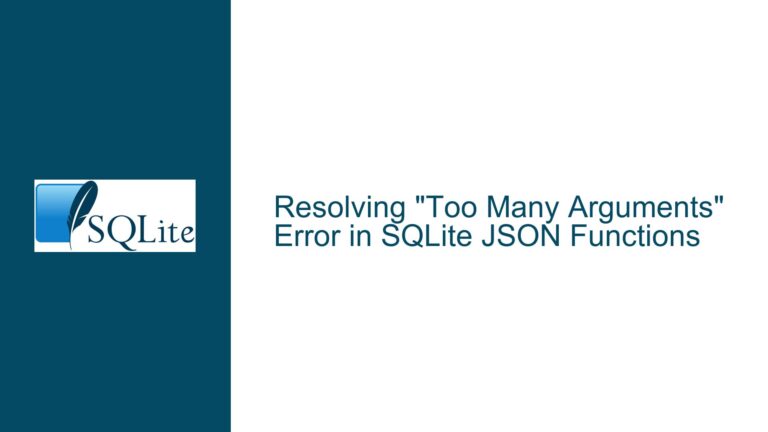SQLite INSERT … RETURNING Syntax and Trigger Limitations
Issue Overview: Misuse of INSERT … RETURNING in SQLite and Trigger Logic
The core issue revolves around the misuse of the INSERT ... RETURNING syntax in SQLite, particularly within the context of a trigger. The user attempted to use INSERT ... RETURNING as part of a SELECT statement, which is not supported in SQLite as of version 3.37. The error message Error: in prepare, near "INSERT": syntax error (1) clearly indicates that SQLite does not recognize the INSERT ... RETURNING clause when used within a SELECT statement. This limitation becomes particularly problematic when trying to implement a trigger that needs to insert a new record into a table and immediately use the newly generated primary key in another operation.
The trigger in question is designed to insert a new record into the localization table if a specific combination of name and languageid does not already exist. The trigger logic involves inserting a new record into the name table to generate a unique id, which is then used in the localization table. However, the attempt to use INSERT ... RETURNING within the trigger to retrieve the newly generated id from the name table fails due to the aforementioned syntax limitation.
Possible Causes: SQLite’s DML and RETURNING Clause Limitations
The primary cause of the issue is SQLite’s current implementation of the RETURNING clause, which is restricted to standalone INSERT, UPDATE, and DELETE statements. As of SQLite version 3.37, the RETURNING clause cannot be used as a row source within a larger query, such as a SELECT statement. This limitation is rooted in the way SQLite processes and optimizes queries. SQLite’s query planner and executor are designed to handle SELECT statements and Data Manipulation Language (DML) statements (INSERT, UPDATE, DELETE) as distinct operations with different execution contexts.
When a SELECT statement is executed, SQLite expects a result set to be returned, which can be further processed or joined with other result sets. On the other hand, DML statements modify the database state and, in the case of RETURNING, can optionally return a result set representing the modified rows. However, SQLite does not allow the result set from a DML statement to be directly used as a row source within a SELECT statement. This is why the attempt to use INSERT ... RETURNING within a SELECT statement results in a syntax error.
Another contributing factor is the user’s reliance on the RETURNING clause to achieve a specific workflow within a trigger. Triggers in SQLite are designed to execute a series of SQL statements in response to specific events (e.g., INSERT, UPDATE, DELETE). However, triggers do not have the ability to return values directly to the calling context. This means that even if INSERT ... RETURNING were supported within a SELECT statement, it would not be straightforward to use the returned value within the trigger logic.
Troubleshooting Steps, Solutions & Fixes: Workarounds and Best Practices
Given the limitations of SQLite’s RETURNING clause and triggers, there are several approaches to address the issue. Each approach involves rethinking the workflow to achieve the desired outcome without relying on unsupported syntax.
1. Using a Temporary Table to Store Intermediate Results
One workaround is to use a temporary table to store intermediate results. This approach involves breaking down the operation into multiple steps:
- First, insert the new record into the
nametable and retrieve the generatedidusing a separateINSERTstatement. - Store the generated
idin a temporary table. - Use the stored
idin the subsequentINSERTstatement for thelocalizationtable.
Here is an example of how this can be implemented:
-- Create a temporary table to store the generated id
CREATE TEMP TABLE temp_id (id INTEGER);
-- Insert a new record into the name table and store the generated id
INSERT INTO name (id) VALUES (NULL);
INSERT INTO temp_id (id) VALUES (last_insert_rowid());
-- Use the stored id in the localization table
INSERT INTO localization (nameid, languageid, name)
SELECT (SELECT id FROM temp_id),
(SELECT id FROM language WHERE name = NEW.language),
NEW.name
WHERE NOT EXISTS (SELECT 1 FROM localization
WHERE name = NEW.name
AND languageid = (SELECT id FROM language WHERE name = NEW.language));
-- Clean up the temporary table
DROP TABLE temp_id;
This approach ensures that the generated id is available for use in subsequent operations without relying on the unsupported INSERT ... RETURNING syntax.
2. Using a User-Defined Function (UDF) to Execute DML Statements
Another approach is to use a User-Defined Function (UDF) to execute DML statements and return the result. This approach leverages SQLite’s ability to extend its functionality through custom functions. The UDF can execute an INSERT statement and return the generated id, which can then be used in subsequent operations.
Here is an example of how a UDF can be implemented to achieve this:
#include <sqlite3.h>
#include <stdio.h>
#include <string.h>
static int singleDbValueSQL(sqlite3 *db, sqlite3_context *context, const char *sql) {
const char *errtext;
sqlite3_stmt *stmt;
int len, bytes, errno;
if (!db) {
errno = SQLITE_ERROR;
} else {
len = strlen(sql);
errno = sqlite3_prepare_v2(db, sql, len, &stmt, &errtext);
if (stmt && errno == SQLITE_OK) {
while ((errno = sqlite3_step(stmt)) == SQLITE_BUSY) {
sqlite3_sleep(1); // Wait for the database to become ready
}
if (errno == SQLITE_ROW || errno == SQLITE_DONE) {
switch (sqlite3_column_type(stmt, 0)) {
case SQLITE_INTEGER:
sqlite3_result_int64(context, sqlite3_column_int64(stmt, 0));
break;
case SQLITE_FLOAT:
sqlite3_result_double(context, sqlite3_column_double(stmt, 0));
break;
case SQLITE_TEXT:
bytes = sqlite3_column_bytes(stmt, 0);
sqlite3_result_text(context, sqlite3_column_text(stmt, 0), bytes, SQLITE_TRANSIENT);
break;
case SQLITE_BLOB:
bytes = sqlite3_column_bytes(stmt, 0);
sqlite3_result_blob(context, sqlite3_column_blob(stmt, 0), bytes, SQLITE_TRANSIENT);
break;
default:
case SQLITE_NULL:
sqlite3_result_null(context);
}
} else {
sqlite3_result_int(context, errno);
}
sqlite3_finalize(stmt);
} else {
sqlite3_result_int(context, errno);
}
}
if (errno != SQLITE_ROW && errno != SQLITE_DONE && errno != SQLITE_OK) {
errtext = sqlite3_errmsg(db);
if (errtext) {
sqlite3_result_text(context, errtext, -1, SQLITE_TRANSIENT);
}
}
return errno;
}
static void evalFunc(sqlite3_context *context, int argc, sqlite3_value **argv) {
if (argc > 1) {
if (sqlite3_value_int(argv[0])) {
evalFunc(context, 1, &argv[1]);
} else if (argc < 3) {
sqlite3_result_null(context);
} else {
evalFunc(context, 1, &argv[2]);
}
} else {
int rc;
sqlite3 *db = sqlite3_context_db_handle(context);
const char *pArg = sqlite3_value_text(argv[0]);
switch (sqlite3_value_type(argv[0])) {
case SQLITE_TEXT:
if (strncmp(pArg, "select ", 7) == 0 ||
strncmp(pArg, "update ", 7) == 0 ||
strncmp(pArg, "insert ", 7) == 0 ||
strncmp(pArg, "delete ", 7) == 0 ||
strncmp(pArg, "drop ", 5) == 0 ||
strncmp(pArg, "create ", 7) == 0 ||
strncmp(pArg, "attach ", 7) == 0 ||
strncmp(pArg, "detach ", 7) == 0 ||
strncmp(pArg, "pragma ", 7) == 0 ||
strncmp(pArg, "alter ", 6) == 0) {
rc = singleDbValueSQL(db, context, pArg);
if (rc != SQLITE_DONE && rc != SQLITE_ROW && rc != SQLITE_OK) {
sqlite3_result_text(context, sqlite3_errmsg(db), -1, SQLITE_TRANSIENT);
}
} else if (strstr(pArg, " from ") || (strchr(pArg, '(') && strchr(pArg, ')'))) {
char *pSQL = sqlite3_mprintf("select %s limit 1", pArg);
rc = singleDbValueSQL(db, context, pSQL);
if (rc != SQLITE_DONE && rc != SQLITE_ROW && rc != SQLITE_OK) {
sqlite3_result_text(context, sqlite3_errmsg(db), -1, SQLITE_TRANSIENT);
}
sqlite3_free(pSQL);
} else {
sqlite3_result_value(context, argv[0]);
}
break;
case SQLITE_BLOB:
default:
sqlite3_result_value(context, argv[0]);
}
}
}
int sqlite3_extension_init(sqlite3 *db, char **pzErrMsg, const sqlite3_api_routines *pApi) {
sqlite3_create_function_v2(db, "eval", 1, SQLITE_UTF8, db, evalFunc, 0, 0, NULL);
sqlite3_create_function_v2(db, "iif", 2, SQLITE_UTF8, db, evalFunc, 0, 0, NULL);
sqlite3_create_function_v2(db, "iif", 3, SQLITE_UTF8, db, evalFunc, 0, 0, NULL);
return SQLITE_OK;
}
This UDF can be used to execute an INSERT statement and return the generated id:
-- Load the extension containing the UDF
.load ./sqlite3_extension
-- Use the UDF to insert a new record and retrieve the generated id
SELECT eval('INSERT INTO name (id) VALUES (NULL) RETURNING id');
The UDF approach provides a flexible way to execute DML statements and retrieve results, but it requires additional setup and may not be suitable for all environments.
3. Revisiting the Trigger Logic to Avoid RETURNING
A third approach is to revisit the trigger logic to avoid the need for INSERT ... RETURNING altogether. This can be achieved by restructuring the trigger to use multiple statements and temporary variables:
CREATE TRIGGER localizations_insert
INSTEAD OF INSERT ON localizations
FOR EACH ROW
BEGIN
-- Check if the record already exists
SELECT id INTO @nameid FROM name WHERE id = NEW.nameid;
SELECT id INTO @languageid FROM language WHERE name = NEW.language;
-- If the record does not exist, insert a new record into the name table
IF @nameid IS NULL THEN
INSERT INTO name (id) VALUES (NULL);
SET @nameid = last_insert_rowid();
END IF;
-- Insert the new record into the localization table
INSERT INTO localization (nameid, languageid, name)
VALUES (@nameid, @languageid, NEW.name);
END;
This approach uses temporary variables (@nameid and @languageid) to store intermediate results and avoids the need for INSERT ... RETURNING. The trigger logic is broken down into multiple steps, each of which can be executed independently.
Conclusion
The issue of using INSERT ... RETURNING within a SELECT statement in SQLite is a result of the database’s current limitations. While this syntax is not supported, there are several workarounds available, including the use of temporary tables, User-Defined Functions (UDFs), and restructuring the trigger logic. Each approach has its own advantages and trade-offs, and the best solution depends on the specific requirements and constraints of the application. By understanding these limitations and exploring alternative approaches, developers can achieve the desired functionality while adhering to SQLite’s capabilities.






